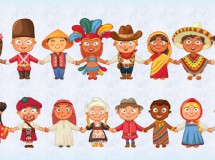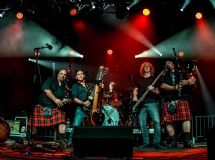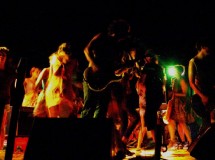Definition
A character is an individual (usually a person) in a narrative in a work of fiction or creative nonfiction. The act or method of creating a character in writing is known as characterization.
In Aspects of the Novel (1927), British author E.M. Forster made a broad yet worthwhile distinction between "flat" and "round" characters. A flat (or two-dimensional) character embodies "a single idea or quality." This character type, Forster said, "can be expressed in one sentence." In contrast, a round character responds to change: he or she "is capable of surprising [readers] in a convincing way."
In certain forms of nonfiction, particularly biography and autobiography, a single character may serve as the primary focus of the text.
See Examples and Observations below. Also see:
- Archetype
- Caricature
- Character (Genre)
- Character Sketch
- Charactonym
- Composing a Character Sketch
- Description
- Epiphany
- Essay Assignment: Profile
- Ethos
Etymology
From the Latin ("mark, distinctive quality") from the Greek ("scratch, engrave")
Examples
- Character Sketch by John McPhee
- "Miss Brill," by Katherine Mansfield
- Miss Brill's Fragile Fantasy: A Critical Essay
- Poor, Pitiful Miss Brill
- "Quality," by John Galsworthy
Examples and Observations:
- "If, in a sense, the flat character embodies an idea or quality, then the 'round' character encompasses many ideas and qualities, undergoing change and development, as well as entertaining different ideas and characteristics."
(Michael J. Hoffman and Patrick D. Murphy, Essentials of the Theory of Fiction, 2nd ed. Duke University Press, 1999)
- Mr. Spock as a Round Character
"Mr. Spock, my favorite character in Star Trek, was James T. Kirk's best friend and one of the most interesting characters ever written for television. Spock was a Vulcan-human hybrid who struggled for many years with his dual heritage before he finally found peace through acceptance of both parts of his heritage."
(Mary P. Taylor, Star Trek: Adventures in Time and Space. Pocket Books, 1999)
- Thackeray's Description of Lord Steyne
"The candles lighted up Lord Steyne's shining bald head, which was fringed with red hair. He had thick bushy eyebrows, with little twinkling bloodshot eyes, surrounded by a thousand wrinkles. His jaw was underhung, and when he laughed, two white buck-teeth protruded themselves and glistened savagely in the midst of the grin. He had been dining with royal personages, and wore his garter and ribbon. A short man was his lordship, broad-chested, and bow-legged, but proud of the fineness of his foot and ankle, and always caressing his garter-knee."
(William Makepeace Thackeray, Vanity Fair, 1847–48)
- Narrator as Character in the Personal Essay
"[In a personal essay], the writer needs to build herself into a character. And I use the word character much the same way the fiction writer does. E.M. Forster, in Aspects of the Novel, drew a famous distinction between 'flat' and 'round' characters--between those fictional personages seen from the outside who acted with the predictable consistency of caricatures, and those whose complexities or teeming inner lives we come to know. . . . The art of characterization comes down to establishing a pattern of habits and actions for the person you are writing about and introducing variations into the system. . . .
"The point is to begin to take inventory of yourself so that you can present that self to the reader as a specific, legible character. . . .
"The need thus exists to make oneself into a character, whether the essay uses a first- or third-person narrative voice. I would further maintain that this process of turning oneself into a character is not self-absorbed navel gazing. But rather a potential release from narcissism. It means you have achieved sufficient distance to begin to see yourself in the round: a necessary precondition to transcending the ego--or at least writing personal essays that can touch other people."
(Phillip Lopate, "Writing Personal Essays: On the Necessity of Turning Oneself Into a Character." Writing Creative Nonfiction, ed. by Carolyn Forché and Philip Gerard. Story Press, 2001)
- Details of Character
"To achieve a fully dimensional character, fictional or real, a writer must watch people closely, much more closely than the average person would. He or she looks especially for anything unusual or distinct about the person or persons involved, but does not ignore what is ordinary and typical. The writer then reports, in as interesting a way as possible, these poses, posturings, habitual gestures, mannerisms, appearances, glances. Not that the writer limits observations to these, but these frequently appear in creative nonfiction writing."
(Theodore A. Rees Cheney, Writing Creative Nonfiction: Fiction Techniques for Crafting Great Nonfiction. Ten Speed Press, 2001)
- Composite Characters in Nonfiction
"The use of a composite character is a dubious device for the writer of nonfiction because it hovers in a gray region between reality and invention, but if it is employed the reader should be made aware of the fact early."
(William Ruehlmann, Stalking the Feature Story. Vintage Books, 1978)
SHARE






































